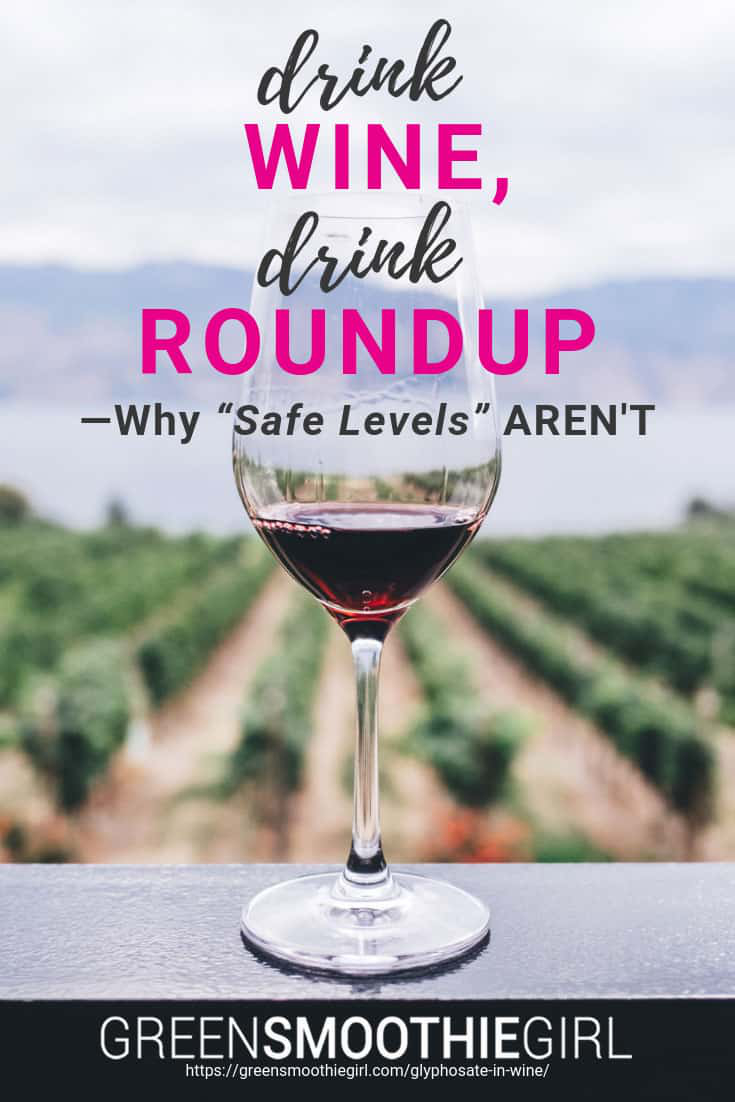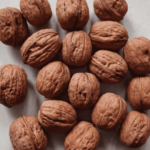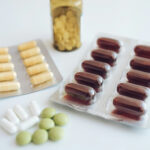Drink Wine, Drink Roundup—Why “Safe Levels” Aren’t
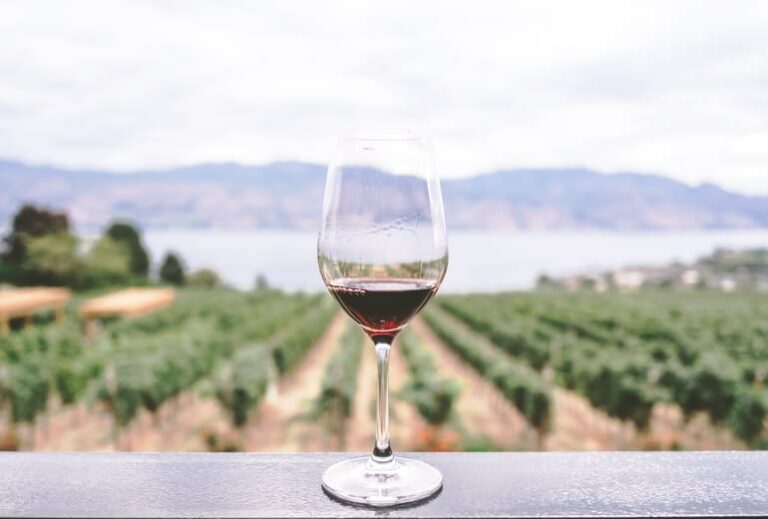
You’ve probably heard, through the grapevine (pun intended), that a glass of red wine with dinner offers certain health benefits such as lowering your cholesterol and regulating blood sugar.
What you might not know is that you may also be drinking glyphosate, the active ingredient and toxic chemical found in Monsanto’s weed killer known as Roundup. Glyphosate is also the base for over 700 other herbicides.
In this post:
Test Results: Even Organic Wine Is Contaminated With Glyphosate
In 2016, Moms Across America, a national group that promotes awareness about GMOs and pesticides, sent in 10 California wines, including organic wines, to be tested for glyphosate-based herbicides. These wines were from the North Coast of California, a premium wine-growing region that includes Napa, Sonoma, and Mendocino counties.
All tested positive. Let me repeat that: All the wines, including organic, tested positive for glyphosate.
The highest level came in at 18.74 parts per billion (ppb) and was over 28 times higher than the other wines. It was a 2013 Cabernet Sauvignon from a conventional vineyard.
The lowest was a 2013 Syrah which came in at .659 ppb from an organic vineyard that had never sprayed. Another organic wine had levels in the range of .913 ppb.1
Even though the U.S. Environmental Protection Agency’s dubious guidelines state that these amounts of glyphosate are well within “safe” levels, the results are alarming for people who think they can avoid this toxic chemical by buying organic wine.
How can organic wines have traces of a chemical that they’ve never used?
There are several ways that glyphosates can infiltrate organic grape vines—via air streams from surrounding vineyards or ranches that are not organic, from irrigation water, or from soil that had at one time been planted with crops using Roundup or another herbicide containing glyphosate.
Monsanto (which was recently purchased by the pharmaceutical giant Bayer, for a price tag of $66 billion), of course, has defended this chemical which was, after all, designed to be toxic, by stating that it is has been “extensively studied.” I wonder if they said the same thing about Agent Orange, PCBs, and DDT? All of these products were once made by Monsanto and are now banned.2
How Does Glyphosate Affect The Human Body?
Even though the EPA’s guidelines allow “safe” levels of glyphosate in foods and drinks, studies link glyphosate with several diseases, including different types of cancer, diabetes, heart disease, infertility, gastrointestinal disorders, and Alzheimer’s. Autism, decreased cognitive function, and behavioral changes have been associated with glyphosate consumed by children.
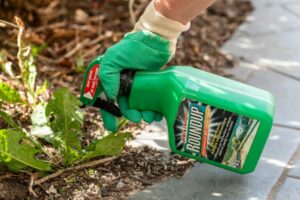
Roundup is a brand-name of an herbicide containing glyphosate, made by Monsanto Company.
Breast Cancer-- A study published in Food and Chemical Toxicology reported that glyphosate induces human breast cancer cell growth via estrogen receptors. Researchers concluded that “low and environmentally relevant concentrations of glyphosate possessed estrogenic activity.”3
Causes Inflammation-- A study reported in Global Research News concluded that the “negative impact (of glyphosate) on the body is insidious and manifests slowly over time as inflammation damages cellular systems throughout the body.” This inflammation ultimately results in many of the prominent diseases of Western civilization: diabetes, heart disease, gastrointestinal disorders, depression, autism, infertility, cancer, and Alzheimer’s.4
Linked to Other Cancers-- In 2015, the World Health Organization (WHO) classified glyphosate as a probable human carcinogen. It has been linked to the rise of several different types of cancer including breast, kidney, pancreas, liver, thyroid, and bladder.5
A house-to-house survey of 65,000 people conducted in the farming communities of Argentina where Roundup is used extensively revealed cancer rates that were two to four times higher than the national average.6
In 2018, a school groundskeeper alleged that Monsanto’s glyphosate-based weed killers, including Roundup, had caused his cancer—non-Hodgkin’s lymphoma. The jury awarded him $289 million in damages. The company now faces more than 5,000 additional lawsuits across the country.7
While Monsanto / Bayer denies that glyphosate causes cancer, the World Health Organization (WHO) has classified it as a probable carcinogen to humans.8
Developmental Disorders-- Glyphosate accumulates in bone marrow, tendons and muscles. Young children and babies are particularly vulnerable due to their still-developing immune systems. The American Academy of Pediatrics (AAP) has stated that prenatal and early childhood exposure to pesticides is “associated with pediatric cancers, decreased cognitive function, and behavioral problems.”9
A Danish pig farmer took 38 malformed piglets into a laboratory in order to determine why they had an extraordinarily high percentage of malformations. The scientists found a correlation between the amount of glyphosate in the sow feed and the abnormalities at birth, stating, “Glyphosate and its commercial herbicides severely affect embryonic and placental cells, producing mitochondrial damage, necrosis, and programmed cell death with doses far below the used agricultural concentrations.”10
Autism, birth defects, and ADHD have notably increased in farming communities that use Roundup.11
Liver and Kidney Disease-- An animal study revealed that rats fed grain from corn with government-approved levels of glyphosate for animal feed resulted in liver and kidney failure as well as premature death and an increase in tumors, particularly mammary. Toxicity occurred at a much lower dose that expected—10,000 times lower than the amount allowed in drinking water in the U.S.12
Destroys Beneficial Gut Flora-- Glyphosate is classified as an antibiotic, meaning that it is designed to kill bacteria. As with other antibiotics, it does not differentiate between the good or the bad. In humans, this means that beneficial gut bacteria are destroyed which leads to a chronic inflammatory state and a leaky gut.13
Which Wines Are Safest?
To sum up, glyphosate is likely in any wine you drink (beer, too, but wine is the focus of this post), and it can have devastating health consequences. What do we do with this information? Quit drinking wine?
If abstinence is off the table, you can still make choices that limit your exposure to glyphosate.
For example, although the Moms Across America test showed even organic wines (and their more exclusive cousins, biodynamic wines) had trace levels of this pesticide, these wines would be preferable to non-organic wines, which tested at up to 28 times more glyphosate.
When considering wines, two questions can help you distinguish wines that are likely to have less glyphosate: What is on the wine label, and what region is the wine from?
What’s On The Wine Label?
In order to make educated choices, let’s take a look at the terminology you may see on wine labels or associated with various types of wines:
Organic
There are several different types of “organic” wines. Wines made with organic grapes means that the grapes are organically grown, and the wine is produced in accordance with the standards of the National Organic Program (NOP).
While no pesticides or herbicides are allowed, processing additives such as acadia gum, oak chips, pectolytic enzymes and tannins are allowed.
Sulfur dioxide (sulfites), a preservative used in wine that is usually responsible for that “day after” headache, can be added up to 100 ppm.14

Sulfites are just one of many types of additives allowed in wines.
If an organic wine is not made with 100 percent organic grapes, it must disclose an ingredient statement which lists the percentage of organic grapes that are used.
[Related: What Does Organic Mean? Should I Pay More For It, Or Not?]
And then there is USDA Certified Organic wine. This means that both the grapes and any additives used in the production, such as yeasts, must be certified organic. Only natural pest control methods are allowed which includes the use of ladybugs and lacewings as well as compost and cover crops. While sulfites are naturally found in wines, no additional sulfites can be added, if a wine is certified organic by the USDA.
Biodynamic
Biodynamic farming was started in the 1920s by Dr. Rudolf Steiner, the same man that created the Waldorf School of Education. While similar to organic farming, biodynamic farming also incorporates spiritual, sustainable, and ecological approaches.
Biodynamic farmers see nature and the vineyard as an interconnected, dynamic whole, and consider their role as part of replenishing and healing the Earth.
Biodynamic farming includes all the practices of organic farming, but goes further in eliminating the use of synthetic pesticides, herbicides, fungicides, fertilizers, and GMOs.
The biodynamic approach to cultivating grapevines for wine also includes some esoteric practices, such as incorporating the four classic elements (air, earth, water, and fire) as they relate to the roots, flowers, fruits, and leaves of the plants. Farmers use the lunar and astrological calendars when considering planting and harvesting, and some apply crushed quartz crystals to the vines to increase what they call the “light energy” of the plant.
Biodynamic winemaking includes the use of natural yeasts, and herbal compost additives which include yarrow, chamomile, nettle, oak bark, dandelion, valerian, and horsetail.
Over 700 producers create biodynamic wine worldwide. A few brands include Quivira Vineyards, Benziger Winery, Nicolas Joly (Loire), Frey Vineyards, Beckmen Vineyards, and Montinore Estate.
If you drink wine, supporting the biodynamic movement is a great way to send a message, voting with your dollars, on what kind of products you want, and don’t want. (USDA Certified Organic would be my second choice, based on the evidence.)
Sustainable
As with other ecologically-minded farming methods, vineyards that call themselves “sustainable” aim to have little negative impact on the land and the environment.
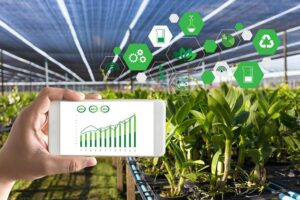
Sustainable farming emphasizes environmental health, economic profitability, and social and economic equity.
At these wineries, you will often find the use of alternative power sources such as solar, as well as recycling and reclamation programs. While this wine is produced in an ecologically responsible manner, it is not regulated. This means that they may or may not use organic ingredients in their processes.
Dry Farm
Dry-farmed crops are produced without the use of irrigation, relying solely on rainfall to water them. In wine grapes, not watering the plants forces them to dig their roots deep into the soil in search of water and nutrients, yielding grapes that have less concentrated sugar and are “drier.”
Proponents of dry-farmed wines believe this process also creates more complex wines that reflect the soil and place from which they come from. Considered an “Old World” method, dry farming has been used to produce wine for centuries in the likes of Spain, France, Italy, and Germany. In fact, the European wine industry has very strict rules regarding irrigation. In some of the world’s finest wine regions, such as Burgundy, Bordeaux, and Brunello, irrigation is not allowed.
So, how did irrigation become the common watering method of choice in the U.S.? In short: Money. More water means more grapes, which means more profit per acre. And irrigation allows for creating a vineyard in areas that really aren’t naturally suited for growing grapes.
Keep in mind, while dry-farming may lead to more complex wines, it does not mean they are organic.
Wineries that produce dry-farmed wines include Arrowood Vineyards, Beckmen Vineyards, Cameron Winery, Evesham Wood, and Analemma Winery, to name a few of the many.
There is also a company named after the process called Dry Farm Wines. They are self-described as the “only health-focused, natural wine club in the world.” Dry Farm Wines sources their wines from vineyards that use dry-farming methods and that also practice natural, sustainable, or biodynamic farming.15
GMO/Non-GMO
Genetically modified organisms (GMOs) are, in the case of wines, grapes and/or yeasts that have been genetically engineered with DNA from bacteria, viruses or other plants and animals.
Gene modification is attractive to some farmers because it creates crops that are resistant to pests and disease. While genetically modified grape vines have been produced in France, South Africa, Chile, Germany, and the U.S., they have not yet been approved for commercial use in wines.
What has been approved in the U.S by the FDA is a genetically modified yeast strain called ML01 that decreases the processing time.

Most GMOs have been engineered to withstand the direct application of herbicide and/or to produce an insecticide.
This yeast is created by inserting two foreign genes, one from the pombe yeast found in Africa and one from the bacteria O. oeni. According to the Organic Consumers Association, Joseph Cummins, a genetics professor at the University of Western Ontario, believes that genetically altering wine yeasts can lead to “unexpected toxicity in the final product.”
As with other GMO crops, this yeast has the potential to contaminate native and traditional wine yeasts through the air and waste and water runoff.16
Unless a wine label states that it is non-GMO, it is possible the wine was made using GM yeast. Your best best is certified organic, which guarantees that all of the ingredients used in the processing of the wine are organic and non-GMO, including the yeast.
Traditional
While you may not see the terms “traditional” or “conventional” on a wine label, meaning that their product contains sprayed grapes, most wines fall into this category unless they are labeled organic, biodynamic, or non-GMO.
Conventional vineyards report that they used to be able to harvest grapes from the same vines for 100 years. With the increasing use of glyphosate and other toxic chemicals, vines are lasting a mere 10 to 12 years.17
It’s clear that if chemicals are depleting the vital nutrients once found in agricultural soils, they are also depleting the vital nutrients that our bodies need to survive. Glyphosate binds to trace minerals and nutrients such as manganese, magnesium, zinc, and calcium in order to disrupt a plant’s growth process. Ultimately, it robs both plants and soil of vital nutrients that, in turn, leads to nutrient-deficient food.
More than 200 different compounds may be used in the process of making conventional wines. The vines or surrounding soil are often treated with pesticides and herbicides such as glyphosate, and sulfites may be added—up to 100 ppm. Enzymes, additives to enhance a wine’s texture, oak extracts, tannins, sugar, gelatin, and chemical stabilizers are frequently used in processing.
What Region Is The Wine From?
The humidity of a wine-growing region can also determine how much herbicide and pesticide may end up in the wine. In most cases, the drier the region, the less spraying is needed. Molds and weeds grow more quickly in humidity, so farmers spray more heavily.
A test conducted by a French consumer organization found that of the 92 bottles of French wine tested, all 92 had traces of pesticide. The wines with the most pesticides came from the humid areas of Bordeaux and Champagne while the drier regions, Provence and the Rhone Valley, contained less. France runs behind only two countries--Japan and the U.S.--in their use of agricultural pesticides.
So, you may wish to avoid all U.S. and French wines, categorically, except for occasionally, organic American wines. (These can be found in most liquor stores, though only rarely in restaurants.)
Drier regions to consider in your search for healthier wines include Chile, Argentina, and California.18
To clarify, just because a region is drier doesn’t necessarily mean that the wine is “dry-farm wine.” Many dry regions must irrigate, so if you’re looking for a wine from grapes that are dry-farmed (i.e. not irrigated), check the label.
What Wine Do I Recommend?
So as not to leave you more confused than ever, let me share my recommendations for safer wines.
As with food, I recommend USDA Certified Organic. If you can find a sustainable or biodynamic wine that is also certified organic, even better! Certification guarantees that the vineyard has been inspected every year, ensuring that the organic integrity of the crop is maintained.
Just a few of the many certified organic wines include Badger Mountain’s Riesling, Nativa Terra Reserva Carmenere, Paul Dolan Vineyards Chardonnay, and Bonterra Vineyards Cabernet Sauvignon.
Another wine company concerned about glyphosates sprouted up in 2018. SmartVine wine entered the market as the first ever glyphosate residue-free certified wine. Owner Christine Fitzgerald’s background as a nutritionist prompted her to formulate wine using a combination of herbal infusions, and without the use of pesticides, herbicides, and insecticides. Unfortunately, because of their high demand and limited sources, they are currently only shipping to businesses and residences within the state of California.

Some wines have significantly higher levels of glyphosate residue than others.
I also think, for regular wine drinkers, Dry Farms Wine is a good option, because the wineries they select in their wine-of-the-month club do not irrigate, and they are all European, where standards are higher. These wines are also, amazingly enough, virtually devoid of sugars, while also having a very smooth taste.
Avoiding Glyphosates
In addition to choosing the healthiest wines, be sure to eat organic whenever possible in order to limit your intake of herbicides such as glyphosate. In addition, including fermented foods in your diet, such as kimchi, helps in the detoxification process of any pesticides that may be in your body.
And, of course, I always recommend incorporating a cleanse/detox into your diet for your body (and mind!) twice a year.
Take a Stand
Until we stand up to massive biotech companies such as Monsanto/Bayer, nothing will change. You can follow the movement online, spread the word by sharing our many posts on this issue on the Green Smoothie Girl Facebook page, and of course, vote with your dollars.
If you’re not a wine drinker, consider this: glyphosates have also been found in bread, cereals, crackers, and even orange juice.
And if you’re a butterfly enthusiast, consider this: Roundup is associated with the destruction of milkweed, the only source of food for Monarch butterfly caterpillars. Monarch butterflies have declined by more than 80 percent over the last two decades since hundreds of millions of tons of glyphosate have been sprayed on crops.19 Many experts theorize that the now endangered honeybee, a pivotal organism in all agriculture, has also been a victim of the spreading of glyphosate.
What can you do? Buy foods and wine from local farmers and wine producers that are certifed organic growers. Join a community supported agriculture (CSA) program. Grow your own food. Money and action speak more than words.
You can also learn more about the action groups and movements working to address these issues. I interviewed Jeffrey Smith, a long-time activist about the GMO movement, called Institute for Responsible Technology. He explains how GMOs and glyphosate are inseparable issues, and his organization has several levels of opportunities for anyone wanting to get involved.
As he puts it, “It’s rather urgent for people, for the first time in human history, to have a positive influence on all living beings and all future generations. So it’s actually an opportunity, rather than a burden.”
Listen to the rest of my interview with Jeffrey Smith (or read the transcript) at my Vibe podcast link for that episode, The Dangers of GMOs with Jeffrey Smith.

Disclosure: This post may contain affiliate links that help support the GSG mission without costing you extra. I recommend only companies and products that I use myself.
Resources
- Honeycutt, Zen. Widespread Contamination of Glyphosate Weed Killer in California Wine. Moms Across America. 03/2016. https://d3n8a8pro7vhmx.cloudfront.net/yesmaam/pages/680/attachments/original/1458848651/3-24-16_GlyphosateContaminationinWineReport_(1).pdf?1458848651
- DeNicola, Mark. Monsanto’s Dirty Dozen: The 12 Most Awful Products Made By Monsanto. Collective Evolution. 10/2014. http://www.anh-usa.org/glyphosate-breakfast-report/
- Thongprakaisang, S. et al. Glyphosate induces human breast cancer cells growth via estrogen receptors. Food and Chemical Toxicology. 09/2013. https://www.ncbi.nlm.nih.gov/pubmed/23756170
- Samsel, Anthony et al. Monsanto Roundup: The Impacts of Glyphosate Herbicide on Human Health. 01/2014. https://www.globalresearch.ca/monsanto-roundup-the-impacts-of-glyphosate-herbicide-on-human-health-pathways-to-modern-diseases/5342520
- Samsel, Anthony et al. Glyphosate, pathways to modern diseases IV: cancer and related pathologies. Journal of Biological Physics and Chemistry. 01/2015. https://www.researchgate.net/publication/283490944_Glyphosate_pathways_to_modern_diseases_IV_cancer_and_related_pathologies
- Pisarenko, Natacha. Potential Effects of Agrochemicals in Argentina. Boston.com. 10/2013. http://archive.boston.com/bigpicture/2013/10/agrochemical_spraying_in_argen.html
- Bellon, Tina. Monsanto Ordered to Pay $289 Million in World’s First Roundup Cancer Trial. U.S. News. 08/2018. https://www.usnews.com/news/top-news/articles/2018-08-10/jury-orders-monsanto-to-pay-290-million-in-california-roundup-cancer-trial
- Van Hoesen, Shannon. World Health Organization Label Glyphosate Probable Carcinogen. 03/2015. https://www.ewg.org/release/world-health-organization-labels-glyphosate-probable-carcinogen
- AAP Makes Recommendations to Reduce Children’s Exposure to Pesticides. American Academy of Pediatrics. 11/2012. https://www.aap.org/en-us/about-the-aap/aap-press-room/Pages/AAP-Makes-Recommendations-to-Reduce-Children%27s-Exposure-to-Pesticides.aspx
- Kruger, Monika. Et al. Detection of Glyphosate in Malformed Piglets. Journal of Environmental & Analytical Toxicology. 2014. https://www.omicsonline.org/open-access/detection-of-glyphosate-in-malformed-piglets-2161-0525.1000230.pdf
- 15 Health Problems Linked to Monsanto’s Roundup. EcoWatch. 01/2015. https://www.ecowatch.com/15-health-problems-linked-to-monsantos-roundup-1882002128.html
- Seralini, G.E. et al. Long term toxicity of a Roundup herbicide and a Roundup-tolerant genetically modified maize. Food and Chemical Toxicology. 2012. https://www.gmoseralini.org/faq-items/what-were-the-studys-findings/
- Shehata, AA et al. The effect of glyphosate on potential pathogens and beneficial members of poultry microbiota in vitro. Current Microbiology. 04/2013. https://www.ncbi.nlm.nih.gov/pubmed/23224412
- Organic Wine Definitions—Behind the Label. Organic Vineyard Alliance. http://organicvineyardalliance.com/organic-wine-definitions-behind-the-label/
- Dry Farm Wines. https://www.dryfarmwines.com/pages/wine-by-nature
- Martenson, Erica. The Dangers of Genetically Modified Yeast Wine. Organic Consumers Association. 09/2015. https://www.organicconsumers.org/news/dangers-genetically-modified-yeast-wine
- Michaelson, Jay. The Ten Worst Things Scott Pruitt’s EPA has Already Done. Daily Beast. 12/2017. https://www.thedailybeast.com/the-ten-worst-things-scott-pruitts-epa-has-already-done
- Gimenez, Bernardo. Which countries’ wines have the least amount of pesticides? The Globe and Mail. 05/2018. https://www.theglobeandmail.com/life/food-and-wine/wine/which-countries-wines-have-the-least-amount-of-pesticides/article26474846/
- Pierce, Charles P. There were 1 Billion Monarch Butterflies. Now there are 93 Million. Esquire. 09/2018. https://www.esquire.com/news-politics/politics/a23472939/monarch-butterflies-endangered-pesticides-climate-change/
Posted in: Eco Friendly Living, Health Concerns, Whole Food




